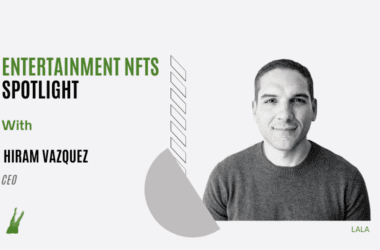Quick take:
- Porter’s strong background in Web2 social media led him to start DSCVR a place where Web3 users and builders can come together and build interactive communities.
- Although the platform was not built to replace Web2 social media, Rick believes that SocialFi is the future of social media.
- Porter says SocialFi has the tools needed to address privacy concerns in social media.
Social Media has been one of the most revolutionary innovations in human conversations. Since Facebook emerged in the early 2000s, conversations between individuals and groups have changed. Yet, even today, the industry continues to evolve.
It is this evolution that Rick Porter, the co-founder and CEO of DSCVR believes Web3 social media will become part of.
Web3 social media, also known as SocialFi after adding various crypto elements like payments and NFTs is a decentralised form of communication that allows users to take full control of their data.
According to Porter, this is one of the reasons SocialFi platforms are well-positioned to address the biggest concern in traditional social media, Privacy.
“Privacy is one of the most important issues that SocialFi can address. SocialFi platforms can offer granular options for users to control the sharing and usage of their data,” says Porter.
However, just like the social media platforms that emerged over the past decade, Porter believes that the industry will require intensive capital deployment for the mass adoption of users.
“While decentralized platforms aim to diversify control from centralized entities, financial resources are still required to build and operate products,” he said.
His company raised $9 million in a seed round led by Polychain Capital in July 2022, which has played a crucial role in the development of DSCVR. “If we want SocialFi to be adopted by the masses, we need a product that is as high quality for the users as a Web2 experience, with all the added crypto features. An effort like this is capital-intensive,” Porter added.
Although Web3 fundraising has been on a decline for the past eight quarters, falling to $1.1 billion in Q4 2023 according to CrunchBase, Porter believes if the evolution in the space continues on the same trajectory, then SocialFi platforms could be the future of social media.
In this Q&A, Porter delves deeper into the future of Web3 Social Media and what it will take to bring the industry to the masses.
Tell us about your journey in Web3 and the inspiration behind DSCVR.
I started at MySpace – one of the earliest social media platforms – where I helped build some of the social and security features on their platform. That’s really where my interest in social came from. After my role at MySpace, I created Fanbacked, a crowdfunding platform built to connect fans with working creators in the entertainment industry, including Rob Zombie and Slash, to help fund their movies.. At Fanbacked, we built numerous social features that enabled these interactions.
Additionally, I developed a news feed-based app for State Street to help surface important news relative to investors’ portfolios, monitoring over 10 billion in assets during my tenure. From these experiences, I went off to become the CEO & CTO of various startups which ultimately led me to start DSCVR. We wanted DSCVR to be a place where Web3 enthusiasts and projects could come together and build communities with powerful crypto functions such as free-flowing tokens, buying, selling, and trading NFTs, and more.
What challenges do SocialFi platforms face in their attempts to bridge Web2 social media to Web3?
Overcoming the pressure to just be an on-chain Web2 social platform is undoubtedly hard and not even a path we have chosen to pursue. DSCVR wasn’t created to compete with Web2 social but rather to complement it. Our priority is delivering users functionalities that they can’t get on Web2, like free-flowing tokens and NFT transactions. Having these types of unique functionalities is one of the main advantages of crypto. Yes, there are challenges in delivering these functionalities in a way that is user-friendly and intuitive, but it’s all part of the process and we’re striving to overcome that for our community.
What is DSCVR doing to address any of those challenges?
DSCVR is creating a SocialFi platform wrapped in an easy-to-use interface where people don’t have to manage wallets or the intricacies of crypto transactions if they don’t want to. DSCVR abstracts the complexity of managing wallets by integrating wallet functionalities seamlessly into a social platform. Instead of users having to set up and manage their wallets, DSCVR provides built-in wallet functionalities that handle blockchain transactions and interactions behind the scenes. While we love the crypto aspect of the platform, we understand others aren’t quite ready for that yet – however, we still welcome them and make it easy for them to join.
Would you say SocialFi is the future of social media? Why?
Absolutely! Social media is continuously evolving. Eventually, SocialFi will be the ‘norm’ as Web3 continues to gain mass adoption. As more and more mainstream users turn to crypto – which most likely occurs after cultural or financial events like we’re seeing now with traditional finance experiencing an excess of inflation and Bitcoin on the rise – they will be able to experience the creative side of this technical innovation through SocialFi.
As new social media trends start to evolve, typically by word of mouth such as we’ve seen with BeReal, Lapse, and the phenomenon of TikTok, SocialFi will be no different. We just need more users to experience it so they tell their friends and their friends tell their friends.
In July 2022, you raised $9M in a seed round led by Polychain. How important have the funds been to your organisation over the past eighteen months?
Capital plays a crucial role in the development and sustainability of DSCVR. While decentralized platforms aim to diversify control from centralized entities, financial resources are still required to build and operate products. If we want SocialFi to be adopted by the masses, we need a product that is as high quality for the users as a Web2 experience, with all the added crypto features. An effort like this is capital-intensive.
One of the biggest challenges that social media platforms face is guaranteeing user privacy. What measures are SocialFi platforms taking to address the issue?
Privacy is one of the most important issues that SocialFi can address. SocialFi platforms can offer granular options for users to control the sharing and usage of their data. They can also offer rewards for when users choose to share data with partners that interest them. This puts users on a level playing field with the projects and platforms they enjoy and is not something you find in Web2.
Do you see increased government involvement in Web3 as an obstacle or catalyst for mass adoption?
Increased government involvement in Web3 can catalyze mass adoption. Clear regulations can enhance trust and reduce uncertainty for businesses and individuals looking to adopt and invest in Web3 applications. When participants have a clear understanding of the rules and expectations, it can encourage wider adoption. For instance, events such as the approvals of the BTC ETFs contribute to raising awareness and educating the public about the potential benefits, use cases, and risks associated with Web3 technologies.
Where do you see the Web3 industry overall in five years?
Over the next five years, I anticipate seeing the Web3 industry as a natural working part of the overall tech ecosystem. As more user-friendly applications and platforms are developed, the barriers to entry for non-technical users will likely decrease. This could lead to a broader user base and greater familiarity with Web3 concepts. Eventually, I believe “Web3 tech” will be ubiquitous, but the companies will not be called “web3”.
Is there anything related to recent events in Web3 you would like to add?
At the tail end of last year, we saw a dappGambl report that 95% of NFT holders’ NFTs were worthless. However, Solana recorded higher NFT trading volumes than Ethereum this month. I believe this is a sign of the promise of NFTs for 2024. With the dappGambl report citing factors of failure such as high energy consumption and lack of demand, NFT creators and brands have the opportunity to hear these concerns and reinvent themselves in 2024.
In my opinion, the concept of an NFT will evolve as fast as it emerged. NFTs were at first just viewed as digital art, but now we are seeing them as keys to communities, brands, tickets and even advertisements. This is the nature of Web3, it’s an industry that develops and grows overnight. There are a lot of concrete concepts within Web3, but how those concepts adapt is what makes Web3 so exciting.
****
Stay up to date:
Subscribe to our newsletter using this link – we won’t spam!





